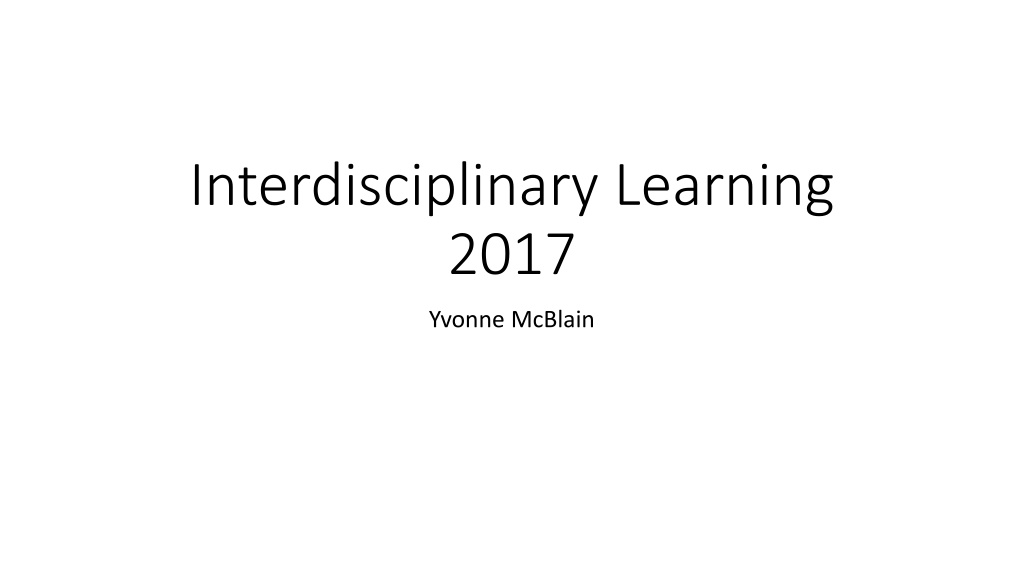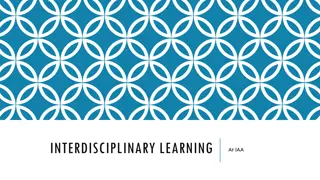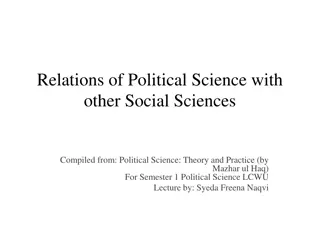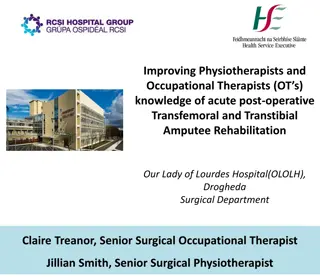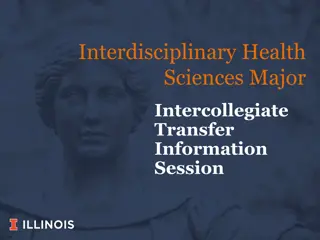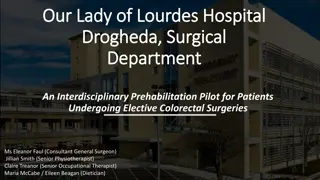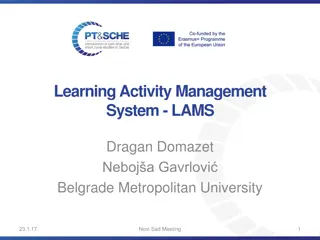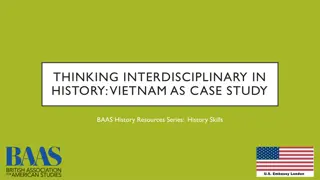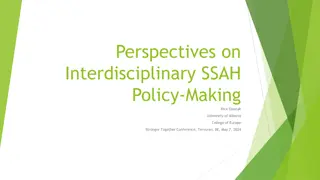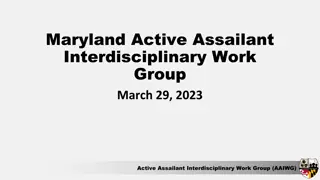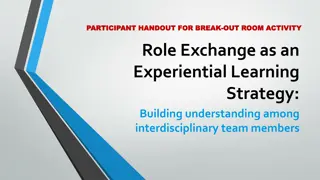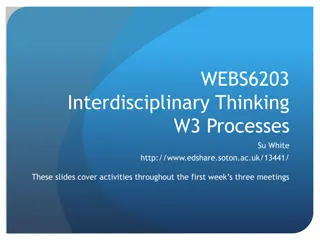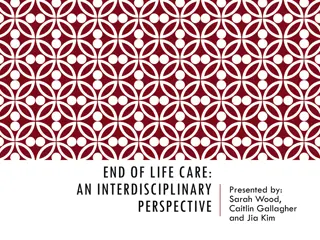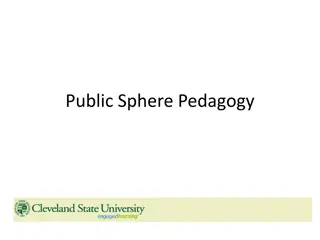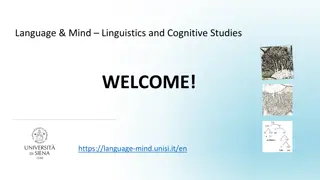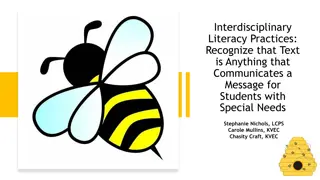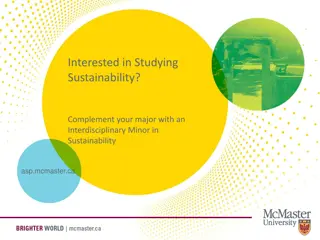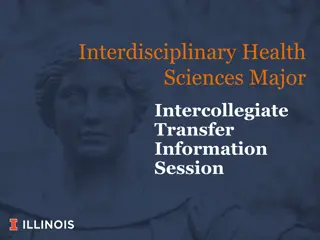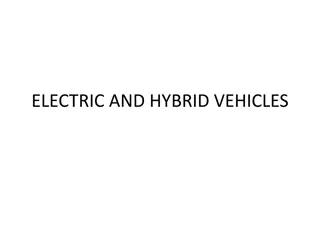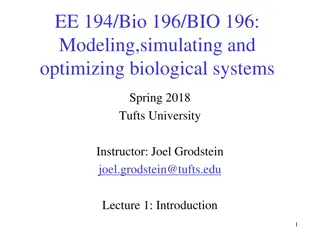Interdisciplinary Learning Development
In this session, participants will explore, plan, and create interdisciplinary learning bundles to enhance their pedagogy. Key messages and types of interdisciplinary learning will be discussed, focusing on making natural connections and deepening learning in a relevant context. The importance of grouping essential outcomes together for effective teaching and assessment will also be highlighted.
Uploaded on Feb 16, 2025 | 1 Views
Download Presentation

Please find below an Image/Link to download the presentation.
The content on the website is provided AS IS for your information and personal use only. It may not be sold, licensed, or shared on other websites without obtaining consent from the author.If you encounter any issues during the download, it is possible that the publisher has removed the file from their server.
You are allowed to download the files provided on this website for personal or commercial use, subject to the condition that they are used lawfully. All files are the property of their respective owners.
The content on the website is provided AS IS for your information and personal use only. It may not be sold, licensed, or shared on other websites without obtaining consent from the author.
E N D
Presentation Transcript
Interdisciplinary Learning 2017 Yvonne McBlain
This morning we are developing our understanding of interdisciplinary learning By lunchtime you will have increased knowledge of and confidence in: 1. Describing good interdisciplinary learning 2. Planning progressive interdisciplinary learning (IDL) 3. Demonstrating how interdisciplinary learning fits within the whole curriculum 4. Identifying how IDL can enhance your own pedagogy
What will we do? 1. Explore what interdisciplinary learning is 2. Remind ourselves of how IDL fits with CfE 3. Analyse experiences and outcomes in detail 4. Plan links between E & Os 5. Turn these links into good IDL 6. Create progressive IDL bundles using social studies 7. Present & evaluate our plan
Skills Skills Skills Skills
Curricular Areas & Subjects Interdisciplinary Learning Your Curriculum includes all that is planned for children and young people throughout their education. It includes four contexts for learning: Ethos & Life of the School Opportunities for Wider Achievement
Key Messages regarding IDL Group E & Os together in ways which best suit learners. Prioritise literacy, numeracy and health and wellbeing across the curriculum to ensure that all learners make the best possible progress. Plan interdisciplinary learning(IDL) to make natural links across learning. Be aware of what is happening in other subjects and make connections. Do not spend time on IDL which does not provide opportunities to apply and deepen learning or is contrived When planning learning, teaching and assessment, E & Os are grouped or bundled together Education Scotland CfE A Statement for Practitioners from HM Chief Inspector of Education, August 2016
What is interdisciplinary learning? There are two broad types of interdisciplinary learning which often overlap. Type 1 Learning based on the connections and differences across two or more disciplines. Type 2 Applying and deepening learning from different disciplines within a real and relevant context
Interdisciplinary Learning what is it? Enabling pupils to see the natural connections within their curriculum Focusing on few, carefully selected E & Os When planning learning, teaching & assessment, E & Os are grouped or bundled together Use skills as your link to give your pupils a task, problem, or big question Your IDL should be built in as an opportunity for pupils to apply learning in an unfamiliar context Do not spend time on IDL which does not provide opportunities to apply and deepen learning or is contrived. Education Scotland A Statement for Practitioners from HM Chief Inspector of Education August 2016
IDL Central lets have a look Blog where news is shared Examples of good practice New ideas and inspiration https://blogs.glowscotland.org.uk/fa/IDLCentral/ Would love to show off your work too - send to yvonne.mcblain@falkirk.gov.uk
Green Let s look at an E & an O! 1. Highlight the skills you see: a) Are these subject specific skills? b) Are there also higher order/transferable skills? 2. Highlight knowledge & understanding being developed in Pink 3. Is this experience or outcome about developing values & attitudes? Choose another way to highlight any of these that you find. 4. Do the remaining verbs give clues about the learning experiences & what the children might actually do?
I understand that evidence varies in the extent to which it can be trusted and can use this in learning about the past. SOC 1-01a Through activities in my local area, I have developed my mental map and sense of place. I can create and use maps of the area. SOC 1-14a Green for skills subject specific & transferable Pink for knowledge/understanding Other for attitudes and values
What can we learn from the lines of development? 1. What did we notice about the learning gap between early and fourth? 2. Any thoughts or observations about how each level develops the skills, knowledge, etc? 3. Did you have any ideas of thoughts about how this affects your planning? 4. Let s read down each column now too does this give you any ideas?
Lets make a social studies bundle 1. Look at the SOC E & Os 2. Find 2 or 3 which have overlapping skills, knowledge and/or attitudes 3. These may belong to one organiser (discipline) within social studies OR they may combine different organisers (disciplines) 4. As well as linking the skills, knowledge, etc, would this group or bundle of E & Os have an overarching purpose? (Principles of relevance, coherence for pupils) 5. Does this bundle work across all levels? Could it progress well? 10 minutes to bundle, then we ll share & comment
Key messages for schools from HMIE 2017 Embed Curriculum for Excellence streamlining approaches to planning & delivering the highest quality of learning, teaching & assessment Streamline assessment plan assessment as part of learning & teaching rather than a bolt on Close poverty-related attainment gap planning additional activities, interventions & resources to raise attainment in literacy & numeracy, continually evaluating the impact on children s progress and attainment Your school will be doing these things in their own various ways we will use a pro forma to help us with the above
Now lets explore whether & how SOC + ? = IDL 1. Think about those skills, knowledge, values & the purpose of your bundle 2. Can you immediately think of any other subject areas which could enrich this bundle? A gut response followed by a proper check! 3. Work as a team to search for complementary E & Os check for: a) Similar skills, knowledge/content, or ways of working b) What would adding these new subject E & Os bring to the learning? Opportunities to apply learning? Challenge & enjoyment/engagement? Breadth, depth & deeper understanding? c) Will the learning be stronger done together than it would be separately? 4. Note the new E & Os to create your IDL bundle (use your activity sheet)
I understand that evidence varies in the extent to which it can be trusted and can use this in learning about the past. SOC 1-01a Through activities in my local area, I have developed my mental map and sense of place. I can create and use maps of the area. SOC 1-14a I can describe, follow and record routes and journeys using signs, words andangles associated with direction and turning. MTH 1-17a I have developed an awareness of where grid reference systems are used in everyday contexts and can use them to locate and describe position. MTH 1-18a
What is progression? In Curriculum for Excellence learners make progress by: continually building on their prior learning; accessing enriching, stimulating, relevant and appropriately challenging learning experiences and; having opportunities for applying, consolidating and reinforcing learning.
Building in Progression making planning, tracking & monitoring manageable Capturing an overview of learning in all 4 contexts, including interdisciplinary context Showing the subjects involved clearly making skills, knowledge, etc visible Building a school s curriculum framework teachers work together to build this (work up front) Give structure with flexibility teachers can identify valuable contexts They can also plan with and respond to pupil interest
What could this look like? Let s try to build a whole bundle 1. Capture your lead subject E & Os 2. Add in your other subject E & Os to make it IDL 3. Consider the Responsibilities of All are there obvious opportunities to broaden, challenge or apply these skills within your developing context? 4. For me: Literacy Reading Finding & using information LIT 1-14a, 1-15a Writing Organising & using information LIT 1-26a Listening & talking - Creating Texts LIT 1-09a, 1-10a
HGIOS 4 2.2 Curriculum level 5 illustration: Rationale and design We work together as a school community to develop, promote and sustain an aspirational vision for our curriculum. The curriculum has a clear vision and rationale shaped by the shared values of the school and its community. Our curriculum is grounded in our commitment to securing children s rights and wellbeing. It takes account of learners entitlements and the four capacities and reflects the uniqueness of our setting. ( 2014 p. 34) Your bundles are your curriculum you are building groups of E & Os which meet the needs of learners across all 4 contexts for learning
The curriculum framework, as laid out in the Building the Curriculum Series, remains the same. Teachers and practitioners provide a curriculum that is coherent and flexible, takes account of the local context and ensures appropriate progression and levels of attainment for all children and young people. The National Improvement Framework increases the focus on literacy, numeracy and health and wellbeing and highlights the need to close the poverty-related attainment gap. The Developing the Young Workforce Programme increases the focus on recognising children s and young people s skills, the links between learning and positive destinations, and access to learning pathways that meets their needs and aspirations. Curriculum for Excellence A Statement for Practitioners from HM Chief Inspector of Education, August 2016
HGIOS 4 2.3 Learning, Teaching & Assessment Level 5 illustration Effective use of assessment Assessment is integral to our planning of learning and teaching. We use a variety of assessment approaches to allow learners to demonstrate their knowledge and understanding, skills, attributes and capabilities in different contexts across the curriculum.
Cross-curricular Learning? Delivering a related bundle of experiences and outcomes through an engaging context. Bundling bundles from different subject areas to help learners engage with the learning e.g. IDL may be built into longer cross-curricular topics or contexts for learning Take a look at the examples from the Aberdeenshire guidance document Talk about your own use of cross-curricular and interdisciplinary learning
The Cross-Cutting Themes Learning for Sustainability We pay particular attention to ensure children and young people experience increasing levels of challenge as they develop skills for learning, life and work. Our staff and partners provide well-planned opportunities for learners to develop an awareness of the world of work. We emphasise enterprise and creativity across all areas of learning. HGIOS 2.2 Curriculum Enterprise & World of Work Creativity
Curricular Areas & Subjects Interdisciplinary Learning Learning for Sustainability Your Curriculum includes all that is planned for children and young people throughout their education. It includes four contexts for learning: Creativity Enterprise & World of Work Ethos & Life of the School Opportunities for Wider Achievement
HGIOS HGIOS 4 4 Self Self- -evaluation? evaluation? Quality Indicators & most relevant key statements 1.2 - Leadership of learning - Children and young people leading learning 1.3 - Leadership of change - Developing a shared vision, values and aims relevant to the school and its community 2.2 Curriculum Rationale and design, Development of the curriculum, Learning pathways, Skills for learning, life and work 2.3 Learning, teaching and Assessment - Learning and engagement, Quality of teaching 2.7Partnerships - The development & promotion of partnerships, Collaborative learning & improvement 3.1 Ensuring wellbeing, equality & inclusion - Inclusion and equality 3.2Raising attainment & achievement - Equity for all learners 3.3Increasing creativity & employability - Creativity skills, Increasing employability skills
This morning have we developed our understanding of interdisciplinary learning? By lunchtime you will have increased knowledge of and confidence in: 1. Describing good interdisciplinary learning 2. Planning progressive interdisciplinary learning (IDL) 3. Demonstrating how interdisciplinary learning fits within the whole curriculum 4. Identifying how IDL can enhance your own pedagogy
